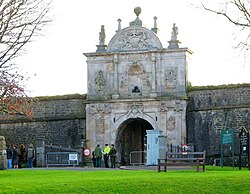Royal Citadel, Plymouth
| Royal Citadel | |
| Devon | |
|---|---|
 The Royal Citadel, seen from Mount Batten | |
| Location | |
| Grid reference: | SX480538 |
| Location: | 50°21’52"N, 4°8’15"W |
| City: | Plymouth |
| History | |
| Built 1660s | |
| Information | |
| Owned by: | The Crown (in the care of English Heritage) |
| Garrison: | 29 Commando Regiment |
The Royal Citadel in Plymouth, Devon stands at the eastern end of Plymouth Hoe overlooking Plymouth Sound and the mouth of Suton Harbour. It encompasses the site of the earlier fort that had been built in the time of Sir Francis Drake.
The fortress was built in the late 1660s to the design of Sir Bernard de Gomme.
History
During the Dutch Wars of 1664-67, King Charles II decided that it was necessary to realise the importance of Plymouth as a channel port. The original plan was to build a regular self-contained fort with five bastions, to the west of Drake's Fort, but this was revised to take in the earlier fort, resulting in the Citadel's irregular outline. Its guns could also fire all round the wall, even into the town (local tradition has it that this was an implied threat because of Plymouth's support for Parliament in the Civil War). De Gomme faced some criticism over his unorthodox design: for instance when Samuel Pepys visited in 1683 he wrote that "De Gomme hath built very sillily".
Fisher's Nose Blockhouse, located on its south east corner, dates from 1490–1540 and was intended to protect the Cattewater. On the opposite bank to Fisher's Nose is the Queen Anne's Battery, dating from 1667.
Work began in March 1665, but it was not until 18 July 1666 that the foundation stone was laid by John Granville, 1st Earl of Bath. This stone, inscribed 'Jo Earle of Bathe 1666', is still in the wall facing the Hoe. Elements from the earlier Tudor fort were incorporated into the new work.[1] The Citadel is built of local limestone, while the Baroque gateway, designed by Sir Thomas Fitz, is of Portland stone. The gateway was originally approached by a drawbridge over a dry moat, but these were removed with all the other outworks in the 1880s.
The Royal Citadel was the most important defensive fortification for over 100 years, with 70 foot high walls, and was regularly strengthened over the years, particularly during the 1750s when it was equipped with 113 guns.
The Royal Citadel is still occupied by the military, being the base of 29 Commando Regiment of the Royal Artillery. This specialist unit of the Army provides artillery support to 3 Commando Brigade of the Royal Marines. Guided tours are sometimes available.[2]


Immediately to the east of the Citadel, and contemporary with it, a Royal Navy Victualling Yard was established to serve the fleet in Plymouth Sound and Sutton Pool. This closed with the establishment of the Royal William Victualling Yard in the 1830s, since when the area has been used as an extension to the military base (and accommodates vehicles too large to pass through the seventeenth-century gateway).[1]
Garrison church
The Royal Chapel of St Katherine-upon-the-Hoe was originally licensed for services in 1371. During the period 1666-1671, the original church was demolished and the present nave, chancel and sanctuary were rebuilt on the same site. The galleries and transepts were added in 1845 and give a cross-like structure to the building. King George V re-granted the title Royal Chapel in 1927 during a visit to the Royal Citadel.
Outside links
| ("Wikimedia Commons" has material about Royal Citadel, Plymouth) |
References
- Gill, Crispin (1993). Plymouth. A New History. Devon Books. pp. 165–166. ISBN 0-86114-882-7.
- Nikolaus Pevsner: The Buildings of England: Devon, 1952; 1989 Penguin Books ISBN 978-0-300-09596-8
- Sellman, R. R. (1985). Aspects of Devon History (New ed.). Exeter: Devon Books. p. 40. ISBN 0-86114-756-1.
- Moseley, Brian (25 January 2011). "Plymouth, Royal Citadel". The Encyclopaedia of Plymouth History. Archived from the original on 28 September 2013. http://www.plymouthdata.info/Royal%20Citadel.htm. Retrieved 12 February 2015.